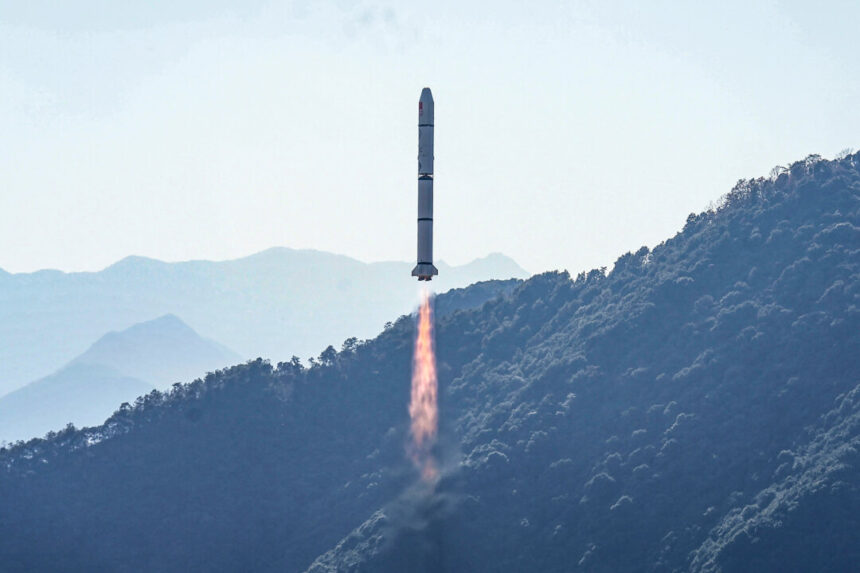Commentary
Supremacy in space-based surveillance and the ability to protect that capability will be a key determinant in any future conflict between the United States and China. Currently, China looks like it is on a
trajectory to win this crucial battle for supremacy.
On Jan. 11, 2007, China used a kinetic kill weapon delivered by a ballistic missile to destroy an aging 2,000-pound Chinese Feng Yun 1C polar weather satellite orbiting 540 miles above Earth. The attack
created a large debris field that continues to endanger other satellites today. Since then, China has accelerated its effort to develop these kinds of anti-satellite (ASAT) weapons.
While China claims that it opposes the militarization of space, it continues to develop capabilities that will allow it
to destroy or disable satellites.
In mid-2021, an interview with a People’s Liberation Army (PLA) Northern Theater engineer revealed that the PLA has three Earth-to-space capable missiles—the DN-1, DN-2, and DN-3—that can reach low, medium, and high orbits carrying anti-satellite weapons. These kinds of tests and reports, coupled with other
more recent actions, show the Chinese regime’s commitment to developing capabilities that will allow it to destroy or disable U.S. military and commercial satellites.
Further, along with the ability to destroy satellites using ground-launched kinetic kill weapons, China has been developing electronic warfare capabilities that can disrupt or disable satellites. What’s more, China has launched “killer satellites” that can maneuver their way next to other satellites to monitor and/or kill them. These capabilities and others are detailed
in a report by the Center for Strategic and International Studies.
The Chinese regime’s aggressive development of ASAT capabilities, coupled with the United States’s
unilateral commitment made by the Biden administration not to test direct ascent anti-satellite weapons, means that China is not only
closing the gap with the United States but, as has been the case with hypersonic weapons, it also appears that China has or soon will surpass the United States when it comes to
anti-satellite capabilities.
This raises the question that, given Beijing’s many statements opposing the militarization of space, would the Chinese regime use these weapons if war broke out over Taiwan? While no one knows for sure, it is hard to imagine that Beijing would not use any means at its disposal to win a war over control of Taiwan.
But regardless of whether or not China’s satellite killing weapons are merely to deter the United States from using its ASAT weapons, China has been rapidly building up other satellite capabilities that it will certainly use in any conflict. Indeed, China
launched its fourth Jielong-3 solid rocket from a sea platform on Sept. 24, adding eight more remote sensing satellites into sun-synchronous orbit. It is the 40
th launch of 2024 and puts the China Aerospace Science and Technology Corporation (CASC) on pace to surpass the r
ecord-setting 67 launches it achieved in 2023. Given China’s
dual-use policy of producing satellites that can be used for both civilian and military purposes, the vast majority likely
have military uses.
In line with this, on May 2, 2024, U.S. Space Forces Maj. Gen. Greg Gagnon, deputy chief of space operations for intelligence,
warned that China is deploying a massive network of remote sensing satellites that will be used to help target U.S. forces if they move to defend Taiwan and that over 50 percent of the 400 satellites deployed into orbit by China over the last two years were designed to track things on Earth. And while the remaining satellites may not specifically track targets on the ground, that does not mean they cannot be used for military applications, such as communication relays or electronic intelligence.
Further indicating its commitment to surpassing the United States, China announced in October 2023 that it will deploy 300 of its highly capable Jilin-1 satellites by the end of 2025 instead of the original planned 138. But it is not just about numbers, as China’s satellites have rapidly advanced in power and sophistication.
These researchers claim one of their satellites (not identified by model) automatically spotted and identified the USS Truman, a Nimitz-class carrier. The satellite then tracked the Truman and its seven escort vessels while continuously updating Beijing with precise real-time coordinates of the Truman’s location.
If China truly has gained the ability to track and relay information in near real-time to its anti-ship ballistic missile forces, then the regime has radically increased the scope and power of its “kill chain,” making it very risky for U.S. Naval forces to operate anywhere near Taiwan.
According to the Chinese researchers, the
satellite’s ability to create actionable data is due to its ability to use highly efficient artificial intelligence algorithms and specialized, dedicated AI hardware to process image data. This data can then be used to provide exact, near real-time targeting data that will allow China to guide one of its extremely powerful DF-21D or DF-26 ship-killing missiles into a maneuvering ship.
Collectively, these new capabilities mean that China can span vast oceans to automatically detect and identify ships and then provide real-time targeting of those ships to missile launch centers.
China has significantly enhanced its capability to target and attack U.S. Navy vessels, particularly aircraft carriers, at sea. With the successful demonstration of its hypersonic anti-ship ballistic missiles, such as the DF-21D and DF-26B, China can now target U.S. carriers with precision long before they reach Taiwan. Additionally, China’s Thousand Sails Constellation program, which aims to deploy thousands of satellites into low-Earth orbit, will provide military capabilities comparable to StarLink. It is important for military planners to reassess their strategies in light of China’s evolving satellite and anti-satellite capabilities. Underestimating China’s potential in a conflict scenario would be unwise, and options to counter China must be reevaluated to effectively address these new challenges.
Source link








